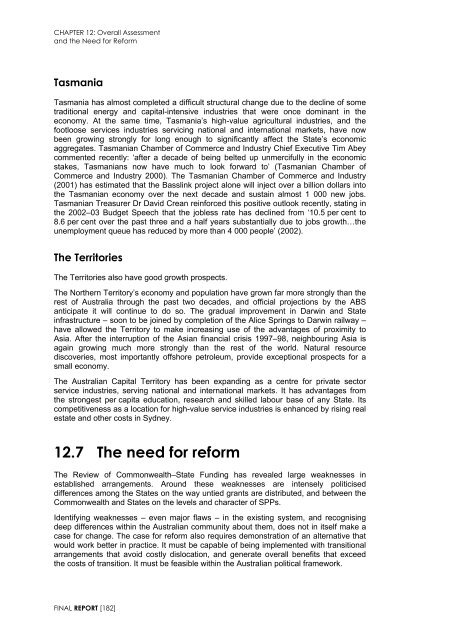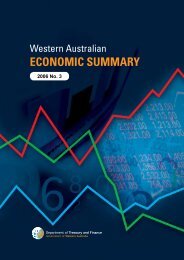Garnaut Fitzgerald Review of Commonwealth-State Funding
Garnaut Fitzgerald Review of Commonwealth-State Funding
Garnaut Fitzgerald Review of Commonwealth-State Funding
You also want an ePaper? Increase the reach of your titles
YUMPU automatically turns print PDFs into web optimized ePapers that Google loves.
CHAPTER 12: Overall Assessment<br />
and the Need for Reform<br />
Tasmania<br />
Tasmania has almost completed a difficult structural change due to the decline <strong>of</strong> some<br />
traditional energy and capital-intensive industries that were once dominant in the<br />
economy. At the same time, Tasmania’s high-value agricultural industries, and the<br />
footloose services industries servicing national and international markets, have now<br />
been growing strongly for long enough to significantly affect the <strong>State</strong>’s economic<br />
aggregates. Tasmanian Chamber <strong>of</strong> Commerce and Industry Chief Executive Tim Abey<br />
commented recently: ‘after a decade <strong>of</strong> being belted up unmercifully in the economic<br />
stakes, Tasmanians now have much to look forward to’ (Tasmanian Chamber <strong>of</strong><br />
Commerce and Industry 2000). The Tasmanian Chamber <strong>of</strong> Commerce and Industry<br />
(2001) has estimated that the Basslink project alone will inject over a billion dollars into<br />
the Tasmanian economy over the next decade and sustain almost 1 000 new jobs.<br />
Tasmanian Treasurer Dr David Crean reinforced this positive outlook recently, stating in<br />
the 2002–03 Budget Speech that the jobless rate has declined from ‘10.5 per cent to<br />
8.6 per cent over the past three and a half years substantially due to jobs growth…the<br />
unemployment queue has reduced by more than 4 000 people’ (2002).<br />
The Territories<br />
The Territories also have good growth prospects.<br />
The Northern Territory’s economy and population have grown far more strongly than the<br />
rest <strong>of</strong> Australia through the past two decades, and <strong>of</strong>ficial projections by the ABS<br />
anticipate it will continue to do so. The gradual improvement in Darwin and <strong>State</strong><br />
infrastructure – soon to be joined by completion <strong>of</strong> the Alice Springs to Darwin railway –<br />
have allowed the Territory to make increasing use <strong>of</strong> the advantages <strong>of</strong> proximity to<br />
Asia. After the interruption <strong>of</strong> the Asian financial crisis 1997–98, neighbouring Asia is<br />
again growing much more strongly than the rest <strong>of</strong> the world. Natural resource<br />
discoveries, most importantly <strong>of</strong>fshore petroleum, provide exceptional prospects for a<br />
small economy.<br />
The Australian Capital Territory has been expanding as a centre for private sector<br />
service industries, serving national and international markets. It has advantages from<br />
the strongest per capita education, research and skilled labour base <strong>of</strong> any <strong>State</strong>. Its<br />
competitiveness as a location for high-value service industries is enhanced by rising real<br />
estate and other costs in Sydney.<br />
12.7 The need for reform<br />
The <strong>Review</strong> <strong>of</strong> <strong>Commonwealth</strong>–<strong>State</strong> <strong>Funding</strong> has revealed large weaknesses in<br />
established arrangements. Around these weaknesses are intensely politicised<br />
differences among the <strong>State</strong>s on the way untied grants are distributed, and between the<br />
<strong>Commonwealth</strong> and <strong>State</strong>s on the levels and character <strong>of</strong> SPPs.<br />
Identifying weaknesses – even major flaws – in the existing system, and recognising<br />
deep differences within the Australian community about them, does not in itself make a<br />
case for change. The case for reform also requires demonstration <strong>of</strong> an alternative that<br />
would work better in practice. It must be capable <strong>of</strong> being implemented with transitional<br />
arrangements that avoid costly dislocation, and generate overall benefits that exceed<br />
the costs <strong>of</strong> transition. It must be feasible within the Australian political framework.<br />
FINAL REPORT [182]

















